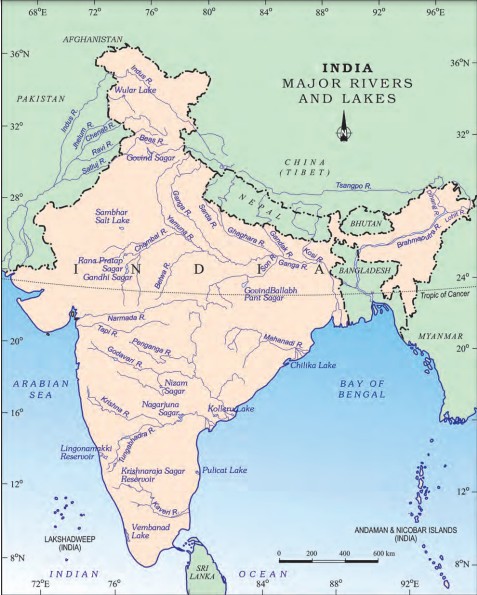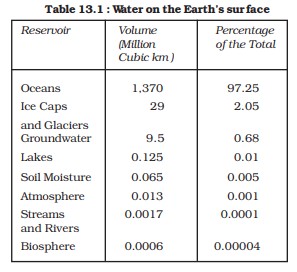There were 12 Questions from Geography in 2021, of which
- 2 Questions on Fundamentals of Physical Geography
- 4 Questions on Indian Physical Geography
- 2 Questions on World Physical Geography
- 4 Questions on Economic Geography
Most of the questions were aimed at testing the conceptual clarity and understanding of basics.
Overall, the level of the questions was moderate.
Previous Year UPSC Geography Questions (PYQs) With Explanation 2021
1. With reference to the Indus river system, of the following four rivers, three of them pour into one of them which joins the Indus directly. Among the following, which one is such a river that joins the Indus directly?
a. Chenab
b. Jhelum
c. Ravi
d. Sutlej
1. Ans: d
Explanation:
The Sutlej rises from the Manasarovar-Rakas Lakes near Darma Pass in western Tibet at a height of 4570 m within 80 Km of the source of the Indus. It enters Himachal Pradesh through Shipki La on the Tibet-Himachal Pradesh boundary. It cuts deep gorges where it pierces the Great Himalayas and other Himalayan ranges. It creates an extraordinary canyon, comparable to the Grand Canyon of Colorado.
Before entering the Punjab plain, it cuts a gorge in Naina Devi Dhar, where Bhakra Dam has been created. It is joined by Beas at Harike. During Its downward journey, it receives the collective drainage of the Ravi, Chenab, and Jehlum rivers (Chenab joins the Satluj after receiving the waters of Jhelum and Ravi rivers) and further downstream, Sutlej joins the Indus a few Kms above Mithankot. Out of a total length of 1450 km, it flows for 1050 km in Indian territory.

Hence, option d is correct.
2. With reference to India, Didwana, Kuchaman, Sargol, and Khatu are the names of:
a) Glaciers
b) Mangrove areas
c) Ramsar sites
d) Saline lakes
2. Ans: d
Explanation:
The Rajasthan Plain
Thar or the Great Indian Desert, covers western Rajasthan and the adjoining parts of Pakistan.
The eastern edge of the Thar Desert there are several saline lakes. They are a great source of common salt and many other salts. The Sambhar, the Didwana, the Degana, the Kuchaman, the Sargol and the Khatu are some of the important lakes. The largest and most outstanding is the Sambhar Lake.
Hence, option d is correct.
3. Consider the following rivers:
1. Brahamani
2. Nagavali
3. Subarnarekha
4. Vamsadhara
Which of the above rises from the Eastern Ghats?
a) 1 and 2
b) 2 and 4
c) 3 and 4
d) 1 and 3
3. Ans: b
Explanation:
Rivers of Odisha
The Brahmani: It is the second largest river in Odisha. Two major rivers, the Sankh and the Koel, originate from the Chhotanagpur Plateau and join at Vedavyasa near Rourkela in the Sundargarh district of Odisha to form a major river called the Brahmani.
Hence, statement 1 is incorrect.
The Nagavali: It originates from the Bijipur hills of the Eastern Ghats near the village Lakhabahal in Kalahandi district. The total length of the river is 217 Km of which 125 Km lies in Odisha and the remaining portion in Andhra Pradesh. The prominent tributaries are Pitadar Nalla, Datteibannda Nalla, Sana-nadi, Barha-nadi, Baldiya-nadi, Sat Nalla, Sitagura Nalla, Ghora Nalla, Sitaghera Nalla, Srikona-nadi, Bonamarha-nadi, Errigeda Nalla & Jhanjhabati river.
Hence, statement 2 is correct.
The Subarnarekha: It originates near Nagri village of the Chhotnagpur plateau of Jharkhand. The total length of the river from its origin to its outfall into Bay of Bengal is 446.12 Km, including 79 km in side Odisha. The prominent tributaries of the Subarnarekha are Raru river, Kanchi river, Damra river, Karru river, Kharkhai river, Chinguru river, Karakari river, Gurma river, Garra river, Singaduba river, Kodia river, Dulunga river and Khaijori river.
Hence, statement 3 is incorrect.
The Vamsadhara: It originates from the flanks of the Durgakangar hills (Lingaraj hills) of the Eastern Ghats in Kalahandi district. The river traverses a total distance of 239 km before its outfall into the Bay of Bengal in Andhra Pradesh. The prominent tributaries of river Vamsadhara are Bhangi, Pedagoda on right side and Badanalla, Chauladhua, Pandaka Nalla, Badajhar, Harbhangi, Sananadi, Mahendratanaya on the left side.
Hence, statement 4 is correct.
The Mahanadi: It originates from the Amarkantak hills of the Bastar Plateau near Pharasiya village in the Raipur district of Chhatisgarh. The river traverses a total distance of 851 Km (in Odisha – 494 Km.) and falls in to the Bay of Bengal.
The major branches and sub-branches of Mahanadi are Kathajodi, Birupa, Kuakhai, Daya, Bhargavi, Kushabhadra, Biluakhai, Devi, Kandala, Luna, Chitrotpala, Karandia, Paika and Badagenguti. All the major branches and sub-branches including Mahanadi falls into the Bay of Bengal except Daya & Bhargavi which fall into Chilika Lake.
The Baitarani: It rises from the Gonasika in the Guptaganga hills (Eastern ghats) of Keonjhar district. The river traverses a total distance of 360 km before falling into the Bay of Bengal.
The Indravati: It originates from the Eastern Ghats of Dandakaranya range in Kalahandi district & flows in a westerly direction; it enters into Jagdalpur district in Chhatisgarh state. It further traverses in the westerly direction & thereafter in the southern direction before finally meeting river Godavari at the border of Maharastra, Chhatisgarh & Andhra Pradesh.
The Kolab: It originates from the Sinkaran hills of the Eastern Ghats in Koraput districts and finally meets the Godavari in Andhra Pradesh
The Rushikulya: It rises from the Rushyamala hills of the Eastern Ghats in Kandhamal district and flows in the south east direction and falls into the Bay of Bengal near Chatrapur. The prominent tributaries of the river Rushikulya are Padma, Boringanalla, Joro, Badanadi, Baghua, Dhanei and Ghodhado. It has no delta in its mouth.
The Bahuda: It rises near the village Luba from the Singharaj hills of the Eastern Ghats in the Gajapati district. It flows in the north east direction upto 55km, south east direction for 17 Km in Odisha before entering Andhra Pradesh to flow for 18 Km. Then it turns in North-east direction for 6 Km in Odisha before meeting the Bay of Bengal near the village Sunapurapeta, Odisha.
The Budhabalanga: The Budhabalanga originates from the Similipal range of hills (Eastern Ghats) on Mayurbhanj district and travels a total length of 198.75 km before it finally empties into the Bay of Bengal.
The Jambhira: It originates from Chandra Reserve forest in Mayurbhanj district and travels a total length of 90 km before it finally falls in the Bay of Bengal.
4. Among the following, which one is the least water-efficient crop?
a) Sugarcane
b) Sunflower
c) Pearl Millet
d) Red gram
Answer: a
Explanation:
Sugarcane is generally considered the least water-efficient crop, meaning it requires a large amount of water to produce a unit of yield compared to many other crops, making it a very water-intensive crop.
Hence, option a is correct.
5. Consider the following statements:
1. In the tropical zone, the western sections of the oceans are warmer than the eastern sections owing to the influence of trade winds.
2. In the temperate zone, westerlies make the eastern sections of oceans warmer than the western sections.
Which of the statements given above is/are correct?
a) 1 Only
b) 2 Only
c) Both 1 and 2
d) Neither 1 nor 2
5. Ans: c
Explanation:
The Planetary winds are the dominant influence on the flow of ocean currents. They are so strong, for example, in the North Indian Ocean, the direction of the currents changes completely with the direction of the monsoon winds which come from the north east in winter and south west in summer.
Between the equator and the tropics, there blow the Trade Winds which move ‘equatorial waters polewards and westwards’, thus warming up the western margins of the oceans and eastern coasts of continents.
Example: the North-East Trade Winds move the North Equatorial Current and its derivatives, the Florida Current and the Gulf Stream Drift to warm the southern and eastern coasts of USA adjacent to the Western Atlantic Ocean. Similarly, the South East Trade Winds drive the South Equatorial Current which warms the eastern coast of Brazil (lying adjacent to the Western Atlantic Ocean) as the warm Brazilian current.
Hence, statement 1 is correct.
In the temperate latitudes, blow the Westerlies. They are less reliable than the Trade Winds. They make the eastern sections of the oceans warmer than the western.
They result in a north-easterly flow in the northern hemisphere. For example, the Warm Gulf Stream is driven to the western coast of Europe as the North Atlantic drift, thus warming the Eastern Atlantic Ocean.
Also, in Southern Hemisphere, the westerlies drive the west wind drift equatorwards as the Peruvian Current off South America and the Benguela current off Southern Africa. Thus in the Southern hemisphere, the Eastern part of the ocean, in this case the Atlantic, gets warm.
Hence, statement 2 is correct.
6. With reference to ‘palm oil’, consider the following statements:
1. The palm oil tree is native to Southeast Asia.
2. The palm oil is a raw material for some industries producing lipstick and perfumes
3. The palm oil can be used to produce biodiesel.
Which of the statements given above are correct?
a) 1 and 2 Only
b) 2 and 3 Only
c) 1 and 3 Only
d) 1, 2 and 3
6. Ans: b
Explanation:
Oil palm trees are native to Africa but were brought to South-East Asia just over 100 years ago as an ornamental tree crop. Now, Indonesia and Malaysia make up over 85% of global supply but there are 42 other countries that also produce palm oil.
Hence, statement 1 is incorrect.
Palm oil is versatile. It is a part of our daily lives, from many of the foods we eat, especially packaged foods, to consumer goods. Beyond enhancing the texture and durability of consumer goods, it plays a vital role in industries like pharmaceuticals and biofuels, contributing significantly to global trade and employment.
Palm oil, obtained from fruits, is used in making soaps, cosmetics, candles, biofuels, and lubricating greases and in processing tinplate and coating iron plates.
Hence, statements 2 & 3 are correct.
7. Consider the following statements:
1. The Global Ocean Commission grants licences for seabed exploration and mining in international waters.
2. India has received licences for seabed mineral exploration in international waters.
3. ‘Rare earth minerals’ are present on the seafloor in international waters.
Which of the statements given above are correct?
a) 1 and 2 Only
b) 2 and 3 Only
c) 1 and 3 Only
d) 1, 2 and 3
7. Ans: b
Explanation:
The International Seabed Authority (ISA), an autonomous international organisation established under the 1982 United Nations Convention on the Law of the Sea, grants the license for sea bed exploration and mining in international waters.
Hence, statement 1 is incorrect.
India was the first country to receive the status of a ‘Pioneer Investor ‘ in 1987 and was given an area of about 1.5 lakh sq km in the Central Indian Ocean Basin (CIOB) for nodule exploration. In 2002, India signed a contract with the ISA and after complete resource analysis of the seabed 50% was surrendered and the country retained an area of 75,000 sq km.
Hence, statement 2 is correct.
The sea floor of various oceans boasts one of the world’s largest untapped collections of rare-earth elements.
Hence, statement 3 is correct.
8. “Leaf litter decomposes faster than in any other biome and as a result, the soil surface is often almost bare. Apart from trees, the vegetation is largely composed of plant forms that reach up into the canopy vicariously, by climbing the trees or growing as epiphytes, rooted on the upper branches of trees”. This is the most likely description of
a) Coniferous forest
b) Dry deciduous forest
c) Mangrove forest
d) Tropical rainforest
8. Ans: d
Explanation:
Tropical rainforests appear like a thick canopy of foliage, broken only where it is crossed by large rivers or cleared for cultivation. All plants struggle upwards for sunlight resulting in a peculiar layer arrangement. The taller trees, smaller trees form the next layer, and the ground is rooted with ferns and herbaceous plants which can tolerate shade.
Almost all the action in a rainforest (not just photosynthesis but also flowering, fruiting, predation and herbivory) happens high in the canopy. Apart from the trees, the vegetation is largely composed of plant forms that reach up into the canopy vicariously, by climbing the trees (vines and lianas, including many species and fig) or growing as epiphytes, which are plants that grow on other plants, rooted on the damp upper branches.
There is intense biological activity in the soil of tropical rainforests. Leaf litter decomposes faster than in any other biome, and as a result the soil surface is often almost bare. The mineral nutrients in fallen leaves are rapidly released, and, as rainfall seeps down the soil profile, nutrients may be carried well below the levels at which roots can recover them. Almost all the mineral nutrients in a rain forest are held in the plants themselves, where they are safe from leaching, when such forests are cleared for agriculture or timber is felled or destroyed by fire, the nutrients are released and leached or washed away.
Hence, option d is correct.
9. The vegetation of the savannah consists of grassland with scattered small trees, but extensive areas have no trees. The forest development in such areas is generally kept in check by one or more or a combination of some conditions. Which of the following are such conditions?
1. Burrowing animals and termites
2. Fire
3. Grazing herbivores
4. Seasonal rainfall
5. Soil properties
Select the correct answer using the codes given below
a) 1 and 2
b) 4 and 5
c) 2, 3 and 4
d) 1, 3 and 5
9. Ans: c
Explanation:
The vegetation of savanna characteristically consists of grassland with scattered small trees, but extensive areas have no trees. The trees actively grow only during the rainy season. In the absence of other controlling factors, these tropical areas would be expected to be covered by forest. But forest development is kept in check, in part by the limited moisture that limits their growth to the rainy season, but also by grazing and fire.
Hence, option c is correct.
10. With reference to the water on the planet Earth, consider the following statements:
1. The amount of water in the rivers and lakes is more than the amount of groundwater.
2. The amount of water in polar ice caps and glaciers is more than the amount of groundwater.
Which of the statements given above is/are correct?
a) 1 Only
b) 2 Only
c) Both 1 and 2
d) Neither 1 nor 2
10. Ans: b
Explanation:
Water on Earth’s surface

Water percentage in and on the Earth:- oceans > ice cape and glaciers > groundwater > lakes > soil moisture > atmosphere > stream & rivers > biosphere.
Hence, statement 1 is incorrect & statement 2 is correct.
11. Consider the following statements:
1. Moringa (drumstick tree) is a leguminous evergreen tree.
2. Tamarind tree is endemic to South Asia.
3. In India, most of the tamarind is collected as minor forest produce.
4. India exports tamarind and seeds of moringa.
5. Seeds of moringa and tamarind can be used in the production of biofuels.
Which of the statements given above are correct?
a) 1, 2, 4 and 5
b) 3, 4 and 5
c) 1, 3 and 4
d) 1, 2, 3 and 5
11. Ans: b
Explanation:
Moringa oleifera is a deciduous tree, occasionally growing up to 15 m in height. Almost all parts of the plant are potentially useful, including for food, fodder, medicine, fuel wood and fertiliser. The seeds are probably the most useful part of the plant, containing a significant percentage of high-quality oil. Recently, the large-scale cultivation of Moringa oleifera has been suggested as a potential source of biofuel.
The exact origin of this species is somewhat obscure, M. oleifera is thought to be indigenous to the sub-Himalayan tracts of northern India.
Hence, statement 1 is incorrect.
Tamarindus indica, commonly known as tamarind, is a frost-free, tropical evergreen tree belonging to family fabaceae, that typically grows to 40-60′ (less frequently to 90′) tall. It is native to eastern Africa, but is now commonly grown and in some cases has naturalised in a number of tropical to subtropical areas around the world.
Hence, statement 2 is incorrect.
The tamarind seed oil has evolved as one of the most essential and economical biodiesel raw material oils.
India exports tamarind and seeds of moringa.
Economically Important Minor Forest Products
Lac (resin), mahuwa flower, mahua fruits, tamarind, Tendu leaves, sal seeds, Chironji, mango, silk cocoons, bamboo, Lac, kullu gum, resins used in incense sticks
Hence, statements 3, 4 & 5 are correct.
12. The black cotton soil of India has been formed due to the weathering of:
a. Brown forest soil
b. Fissure volcanic rock
c. Granite and schist
d. Shale and limestone
12. Ans: b
Explanation:
The black cotton soils are also called regur. These are black cotton because cotton is the most important crop grown on these soils. These soils have been formed due to the solidification of lava spread over large areas during volcanic activity in the Deccan Plateau, thousands of years ago.
The black colour of these soils has been attributed to the presence of a small proportion of titaniferous magnetite or even to iron and black constituents of the parent rock.
Black soil is mainly found in Maharashtra, Madhya Pradesh, parts of Karnataka, Telangana, Andhra Pradesh, Gujarat and Tamil Nadu.
Hence, option b is correct.



